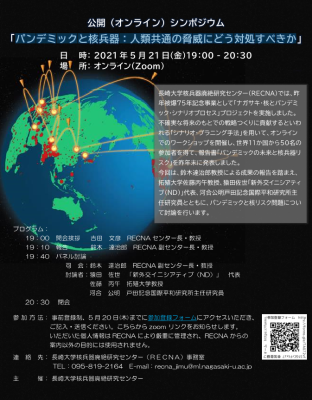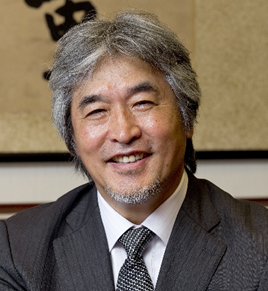動画公開のお知らせ
長崎大学核兵器廃絶研究センター(RECNA)主催による公開シンポジウム「パンデミックと核兵器:人類共通の脅威にどう対処すべきか」(2021年5月21日オンライン開催)の動画を公開しました。どうぞ、ご覧ください。
|
|
新着情報What’s New
動画公開のお知らせ
長崎大学核兵器廃絶研究センター(RECNA)主催による公開シンポジウム「パンデミックと核兵器:人類共通の脅威にどう対処すべきか」(2021年5月21日オンライン開催)の動画を公開しました。どうぞ、ご覧ください。
|
|
平素より核兵器廃絶研究センターのウェブサイトを閲覧いただきまして誠にありがとうございます。
この度、下記日程におきましてサーバーのメンテナンスを実施させていただきます。
メンテナンス実施の間は、一時、RECNAウェブサイトを閲覧できなくなることがあります。
ご迷惑をおかけしますが、どうぞ、よろしくお願いいたします。
【実施日時】
日 程: 2021 年 5 月 20 日(木)
時 間: 14:00 ~ 16:00
 長崎大学核兵器廃絶研究センター(RECNA)では、昨年被爆75年記念事業として「ナガサキ・核とパンデミック・シナリオプロセス」プロジェクトを実施しました。不確実な将来のもとでの戦略つくりに貢献するといわれる「シナリオ・プラニング手法」を用いて、オンラインでのワークショップを開催し、世界11か国から50名の参加者を得て、報告書「パンデミックの未来と核兵器リスク」を昨年末に発表しました。
長崎大学核兵器廃絶研究センター(RECNA)では、昨年被爆75年記念事業として「ナガサキ・核とパンデミック・シナリオプロセス」プロジェクトを実施しました。不確実な将来のもとでの戦略つくりに貢献するといわれる「シナリオ・プラニング手法」を用いて、オンラインでのワークショップを開催し、世界11か国から50名の参加者を得て、報告書「パンデミックの未来と核兵器リスク」を昨年末に発表しました。
今回は、鈴木達治郎教授による成果の報告を踏まえ、拓殖大学佐藤丙午教授、猿田佐世「新外交イニシアティブ(ND)」代表、河合公明戸田記念国際平和研究所主任研究員とともに、パンデミックと核リスク問題について討論を行います。
動画教材公開のお知らせ
この動画は、長崎大学核兵器廃絶研究センター(RECNA)主催による被爆75年記念特別シンポジウム「平和・軍縮教育の新たな展開~核兵器禁止条約の時代を見据えて」(2020年11月25日)における山極壽一氏(京都大学前総長)による特別講演「暴力と戦争の由来:ゴリラの視点から人類の進化を考える」を編集したものです。
|
|
講師: 山極 壽一 氏(京都大学前総長)

<プロフィール>
1952年、東京生まれ。京都大学大学院博士課程単位取得退学、理学博士。現在、日本モンキーセンター博物館長。第26代京都大学総長、国立大学協会会長、日本学術会議会長、日本霊長類学会会長、国際霊長類学会会長を歴任、専攻は霊長類社会生態学、人類進化論。アフリカ各地でゴリラの行動や生態をもとに初期人類の生活を復元し、人類に特有な社会特徴の由来を探っている。主な著書に、『暴力はどこからきたか』(2007年、NHK出版)、『家族進化論』(2012年、東京大学出版会)、『「サル化」する人間社会』(2014年、集英社)、『ゴリラからの警告-人間社会、ここがおかしい』(2018年、毎日新聞出版)、『スマホを捨てたい子どもたち』(2020年、ポプラ社)、『人生で大事なことはみんなゴリラから教わった』(2020年、家の光協会)など。
英語版は こちら